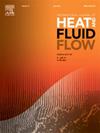Nonlinear dual-mode instability of viscoelastic planar liquid sheet in two inviscid gas streams of equal velocities
IF 2.6
3区 工程技术
Q2 ENGINEERING, MECHANICAL
International Journal of Heat and Fluid Flow
Pub Date : 2024-10-11
DOI:10.1016/j.ijheatfluidflow.2024.109587
引用次数: 0
Abstract
The weakly nonlinear instability of viscoelastic planar liquid sheet subjected to simultaneous linear sinuous and varicose perturbations (i.e., dual-mode) has been studied. In the analysis of temporal instability, we considered the case where both sides of the sheet have an inviscid gas moving at the same velocities. The solutions of second-order interfacial perturbation instability were derived based on the perturbation technique, followed by a parametric study. The impact of different disturbance modes on the instability of the upper and lower interfaces was studied under different initial phase differences. When the linear sinuous and varicose modes start with equal initial amplitudes, the influence of the first harmonic of the sinuous mode is notably significant due to its relatively large amplitude. We also checked the influences from several parameters, like elasticity number, time constant ratio on the instability of the sheet under a fixed gas–liquid velocity difference. The results demonstrate that elasticity number has a non-monotonic dual effect on the instability of the sheet: Within a lower range of elasticity numbers, the instability of the sheet is suppressed; Conversely, the instability is enhanced at higher elasticity numbers. Furthermore, under the condition of maintaining a fixed gas–liquid velocity difference, increasing the gas–liquid velocity ratio leads to a decrease in the maximum linear growth rate of perturbations, thereby suppressing the instability of the sheet. However, it has no significant effect on the amplitude of second-order perturbations and the breakup profile of the sheet.
粘弹性平面液面在两股等速不粘性气流中的非线性双模不稳定性
我们研究了粘弹性平面液面同时受到线性正弦和曲折扰动(即双模式)时的弱非线性不稳定性。在分析时间不稳定性时,我们考虑了液面两侧都有以相同速度运动的不粘性气体的情况。根据扰动技术推导出了二阶界面扰动不稳定性的解,随后进行了参数研究。研究了在不同初始相位差条件下,不同扰动模式对上下界面不稳定性的影响。当线性正弦模态和曲折模态以相等的初始振幅开始时,正弦模态的第一次谐波由于振幅相对较大而影响显著。我们还检验了弹性数、时间常数比等参数对固定气液速度差下薄片不稳定性的影响。结果表明,弹性数对薄片的不稳定性具有非单调的双重影响:在较低的弹性数范围内,薄片的不稳定性受到抑制;相反,弹性数越高,不稳定性越强。此外,在保持固定气液速度差的条件下,增加气液速度比会导致扰动的最大线性增长率下降,从而抑制薄片的不稳定性。然而,它对二阶扰动的振幅和薄片的破裂剖面没有明显影响。
本文章由计算机程序翻译,如有差异,请以英文原文为准。
求助全文
约1分钟内获得全文
求助全文
来源期刊

International Journal of Heat and Fluid Flow
工程技术-工程:机械
CiteScore
5.00
自引率
7.70%
发文量
131
审稿时长
33 days
期刊介绍:
The International Journal of Heat and Fluid Flow welcomes high-quality original contributions on experimental, computational, and physical aspects of convective heat transfer and fluid dynamics relevant to engineering or the environment, including multiphase and microscale flows.
Papers reporting the application of these disciplines to design and development, with emphasis on new technological fields, are also welcomed. Some of these new fields include microscale electronic and mechanical systems; medical and biological systems; and thermal and flow control in both the internal and external environment.
 求助内容:
求助内容: 应助结果提醒方式:
应助结果提醒方式:


